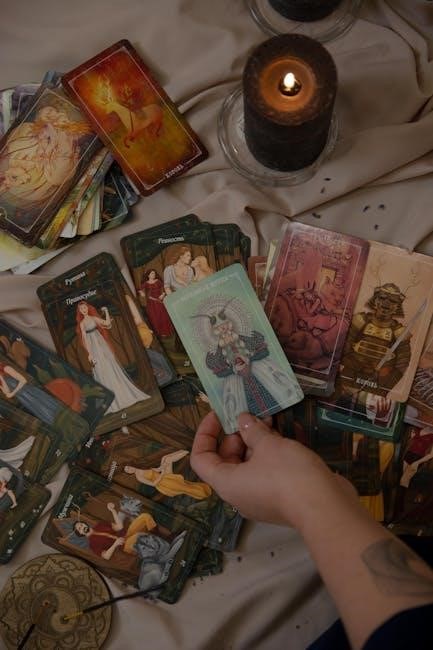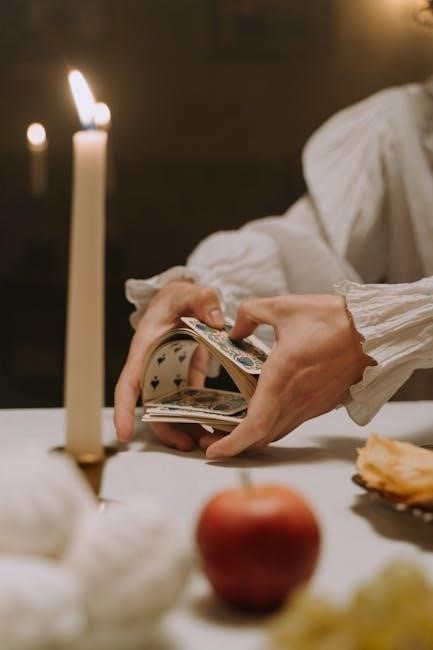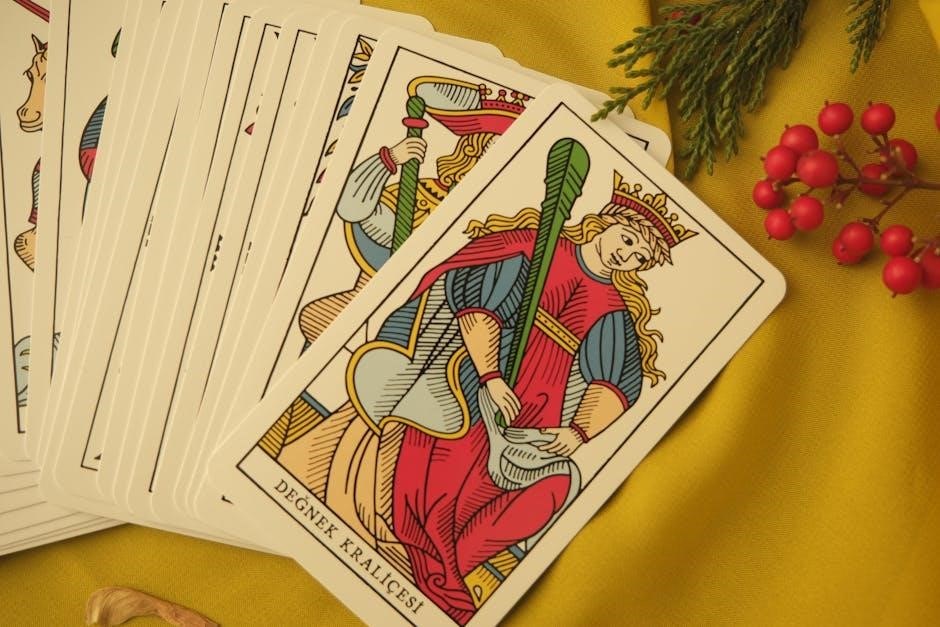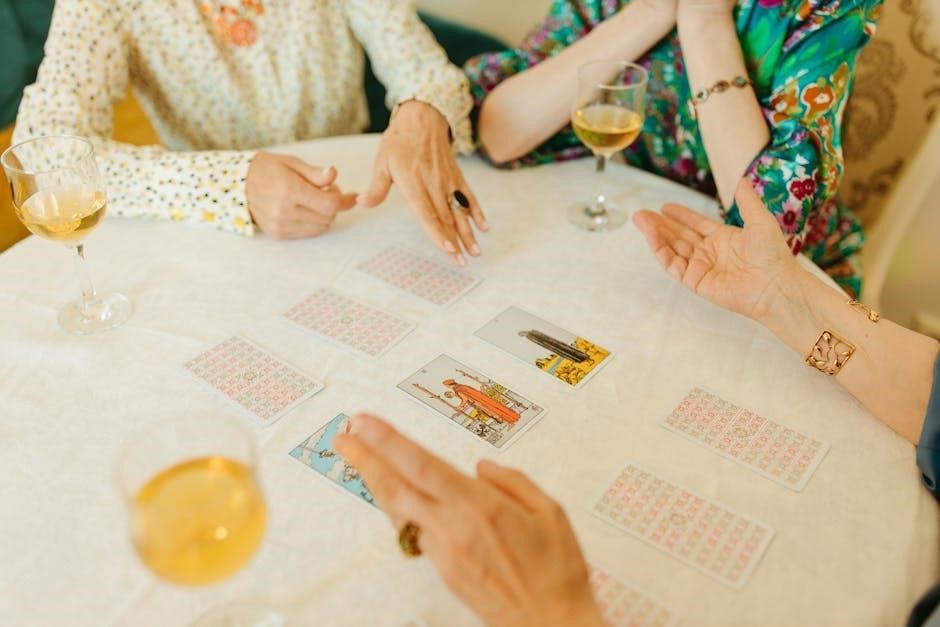Discover the ancient art of cartomancy‚ where playing cards reveal insights into the past‚ present‚ and future. Learn how a standard deck can unlock hidden meanings and guide self-reflection.
What is Cartomancy?
Cartomancy is the ancient practice of using playing cards for divination and self-reflection. It involves interpreting the symbolism‚ suits‚ and imagery on the cards to gain insights into a person’s past‚ present‚ and future. This tradition taps into the intuitive connection between the cards and the querent‚ offering guidance and clarity. Unlike tarot‚ cartomancy relies on a standard deck‚ with each suit (hearts‚ diamonds‚ clubs‚ spades) representing different aspects of life‚ such as emotions‚ finances‚ friendships‚ and challenges. Court cards often symbolize people or archetypes‚ while number cards carry specific meanings tied to their numerology. Cartomancy is a versatile and accessible tool for those seeking deeper understanding and direction.
A Brief History of Playing Cards

Playing cards have a rich history tracing back over 500 years‚ with origins debated between Egypt‚ China‚ and Europe. Initially used for gaming‚ their symbolism and imagery soon lent themselves to divination. The four suits—hearts‚ diamonds‚ clubs‚ and spades—represent different aspects of life‚ such as emotions‚ finances‚ friendships‚ and challenges. Court cards often symbolize individuals or archetypes‚ while number cards carry specific meanings tied to numerology. Over time‚ cartomancy evolved‚ blending folklore and intuition‚ making playing cards a versatile tool for fortune-telling. Today‚ they remain a popular and accessible method for gaining insights and exploring the mysteries of destiny.
Why Playing Cards are Used for Fortune Telling
Playing cards are widely used for fortune-telling due to their rich symbolism and versatility. Each suit—Hearts‚ Diamonds‚ Clubs‚ and Spades—represents different aspects of life‚ such as emotions‚ finances‚ friendships‚ and challenges. The deck’s structure‚ including number cards and court cards‚ offers a detailed framework for interpreting past‚ present‚ and future events. Their accessibility and familiarity make them an appealing tool for divination. Additionally‚ the intuitive connection between the cards and human experiences allows for meaningful insights. Over time‚ playing cards have evolved from a gaming tool to a popular medium for self-reflection and uncovering hidden truths‚ blending tradition with modern practices.

Preparing for a Reading
Begin by shuffling the deck to align your energy with the cards. Set a calm atmosphere‚ focus your intentions‚ and prepare for meaningful insights and guidance.
How to Shuffle and Cut the Cards

To begin‚ shuffle the deck thoroughly to mix the cards and clear their energy. Use a riffle or overhand shuffle for an effective mix. Once shuffled‚ invite the querent to cut the deck into three piles with their left hand. This step allows the querent’s energy to influence the reading. Gently gather the piles from left to right to maintain the flow of energy. The shuffling and cutting process ensures the cards are randomized and attuned to the querent’s vibrations. Proper handling enhances the reading’s accuracy and connection to the seeker’s journey.
Choosing the Right Deck
Selecting the right deck is crucial for effective fortune-telling. Opt for a deck that resonates with you intuitively‚ as it enhances your connection to the cards. Traditional decks with symbolic imagery are ideal for cartomancy‚ as they carry rich‚ established meanings. Avoid overly elaborate designs that may distract from interpretation. Some practitioners prefer vintage or antique decks‚ believing they hold historical energy. A standard 52-card deck without jokers is recommended for simplicity. Ensure the deck is well-shuffled and clean of negative energy. Over time‚ the deck will absorb your vibrations‚ making it a trusted tool for readings. Choose wisely‚ as your deck becomes an extension of your intuition and insight.
Setting the Mood for a Reading
Creating the right atmosphere is essential for a meaningful reading. Find a quiet‚ comfortable space free from distractions. Soft lighting and a clean‚ clutter-free surface enhance focus. Consider cleansing the area with sage or incense to remove negative energy. Place a cloth or mat on the table to protect the cards and add a ritualistic touch. Ensure the person being read is calm and open-minded. Some practitioners play soft music or use aromatherapy to deepen relaxation. The environment should foster trust and clarity‚ allowing for a deeper connection to the cards and their insights.

Understanding Card Meanings
Unravel the mysteries of playing cards‚ where each suit‚ number‚ and court card holds unique symbolism. Learn how to interpret their traditional meanings for deeper insights.
The Significance of Suits (Hearts‚ Diamonds‚ Clubs‚ Spades)
In cartomancy‚ each suit in a playing card deck holds distinct symbolic meanings. Hearts represent emotions‚ relationships‚ and love‚ often reflecting personal matters. Diamonds symbolize finances‚ career‚ and material success‚ focusing on practical aspects of life. Clubs are associated with friendships‚ community‚ and new opportunities‚ emphasizing collaboration and social interactions. Spades‚ the most complex suit‚ signify challenges‚ transformation‚ and spiritual growth‚ often representing difficult decisions or change. Understanding the suits’ elemental connections—Hearts with water‚ Diamonds with earth‚ Clubs with air‚ and Spades with fire—deepens their interpretation. Each suit’s energy influences the reading‚ providing a framework for interpreting the cards’ messages about past‚ present‚ and future events.
Interpreting Number Cards
Number cards in a playing deck hold specific meanings tied to their numerical values. Aces often symbolize new beginnings or opportunities‚ while tens represent completion or fulfillment. Cards 2 through 9 reflect their numerical energies: 2 for balance‚ 3 for growth‚ 4 for stability‚ 5 for change‚ 6 for harmony‚ 7 for manifestation‚ 8 for abundance‚ and 9 for completion. The interpretation may vary based on the card’s suit and position in the spread. For example‚ a 5 of Hearts might indicate emotional conflict‚ while a 5 of Diamonds could signal financial challenges; Context is key to understanding their messages.
The Role of Court Cards (Jack‚ Queen‚ King)
Court cards—Jack‚ Queen‚ and King—represent individuals or archetypes in a reading. The Jack often signifies a young person or a messenger‚ embodying curiosity and action. The Queen reflects feminine energy‚ representing nurturing‚ intuition‚ or an influential woman. The King symbolizes authority‚ leadership‚ or a male figure‚ offering wisdom and structure. These cards can also indicate personality traits or roles in the querent’s life. Their interpretations vary by suit and context‚ providing deeper insights into relationships‚ challenges‚ or guidance. For example‚ a King of Hearts might suggest emotional wisdom‚ while a Queen of Spades could indicate transformation or upheaval. Court cards enrich the narrative of a spread‚ offering human dynamics and complexities.

Common Spreads and Layouts
Explore popular card layouts like the three-card spread‚ Celtic Cross‚ and 21-card spread‚ designed to organize cards for clear insights into past‚ present‚ and future.
The Three-Card Spread (Past‚ Present‚ Future)
This simple yet powerful layout involves three cards‚ each representing the past‚ present‚ and future; The first card reveals past influences‚ the second highlights the current situation‚ and the third forecasts future outcomes. It’s ideal for gaining clarity on a specific question or situation. To perform this spread‚ shuffle the deck‚ lay out the cards in a row‚ and interpret their meanings in sequence. The past card provides context‚ the present card identifies current challenges or opportunities‚ and the future card offers guidance or predictions. This spread is a popular choice for beginners‚ as it provides a clear and concise reading. Use it to focus on a single question for the most insightful results.
The Celtic Cross Spread
The Celtic Cross Spread is one of the most popular and intricate layouts in cartomancy‚ offering deep insights into a situation. It consists of ten cards‚ arranged in a cross shape‚ with each position holding specific meanings. The center card represents the current situation‚ while the vertical line above and below it reflects the conscious and subconscious influences. The horizontal line to the left and right symbolizes the past and future. Additional cards provide context‚ challenges‚ and outcomes. This spread is ideal for complex questions‚ as it reveals underlying dynamics and potential paths forward. To perform the Celtic Cross‚ shuffle the deck‚ lay out the cards in the cross pattern‚ and interpret each position step-by-step for a comprehensive reading.
Using a 21-Card Spread
The 21-Card Spread is a detailed and comprehensive layout used for complex questions or life situations. It involves arranging the cards in a specific pattern‚ often three rows of seven cards each‚ with the middle row representing the current situation. The first row symbolizes the past‚ the second the present‚ and the third the future. Additional cards placed above and below the central row provide deeper insights into challenges‚ opportunities‚ and outcomes. This spread is particularly useful for gaining a holistic understanding of a situation and identifying underlying influences. To perform it‚ shuffle the deck‚ lay out the cards in the prescribed pattern‚ and interpret them sequentially for a meaningful and in-depth reading.

Advanced Techniques
Exploring advanced techniques like card combinations‚ reversals‚ and context reading can deepen your understanding and enhance the accuracy of your readings.
Combining Cards for Deeper Insights
Combining cards is an advanced technique that reveals deeper meanings by examining how cards interact. This method allows readers to uncover hidden connections and overarching themes in a spread. For example‚ pairing a Heart card with a Spade may indicate emotional challenges influenced by external circumstances. By analyzing the relationships between suits‚ numbers‚ and court cards‚ one can gain a more nuanced understanding of the situation. This approach encourages intuition‚ as the reader must interpret how the cards collectively tell a story. Over time‚ practice enhances the ability to synthesize these combinations‚ offering richer and more accurate insights into the past‚ present‚ and future.
Reversals and Their Meanings
Reversals in cartomancy offer deeper layers of interpretation‚ often indicating the opposite or a blockage of the card’s upright meaning. For example‚ a reversed Ace of Hearts might suggest emotional closure or delayed love‚ while a reversed Knight of Wands could signify stalled progress or impulsiveness. Reversals can also signal unconscious patterns or hidden influences. Interpreting reversals requires intuition‚ as their meaning depends on the context of the spread and surrounding cards. They add complexity to readings‚ revealing nuances like delays‚ resistances‚ or even the need for reflection. Mastering reversals enhances accuracy‚ allowing readers to address challenges and opportunities more effectively. This technique highlights the dynamic nature of cartomancy.
Reading the Cards in Context
Understanding the context of each card is essential for accurate interpretations. The position of a card within a spread‚ its relationship to other cards‚ and the question being asked all influence its meaning; For example‚ a card in the “past” position may reflect previous events‚ while the same card in the “future” position could indicate upcoming trends. Surrounding cards can amplify or modify its interpretation‚ creating a nuanced narrative. Contextual reading allows for a deeper connection to the querent’s situation‚ making the reading more personalized and relevant. This approach emphasizes the interconnectedness of the cards‚ revealing a more comprehensive and meaningful story.

Practical Examples
Step-by-step guides and real-life scenarios demonstrate how to interpret card spreads‚ offering clear examples for beginners to practice and refine their cartomancy skills effectively.
A Step-by-Step Guide to Performing a Reading
Start by shuffling the deck to infuse your energy. Have the querent cut the cards or choose specific piles. Lay out the cards in a chosen spread. Interpret each card based on its position and symbolism‚ considering suit meanings and any reversals. Combine card insights for a cohesive narrative. Conclude by summarizing the reading‚ offering guidance and actionable advice. Practice regularly to refine intuition and accuracy‚ enhancing your ability to provide meaningful readings. This structured approach ensures clarity and depth in each session‚ making cartomancy accessible and impactful for both beginners and experienced readers alike.
Interpreting a Sample Spread
Begin by analyzing each card’s position in the spread‚ as its placement holds specific significance. For example‚ in a three-card spread‚ the first card represents the past‚ the second the present‚ and the third the future. Examine the card symbols‚ suits‚ and any reversals‚ as these influence interpretation. Hearts often signify emotions‚ diamonds relate to finances‚ clubs to community‚ and spades to challenges. Court cards typically represent people or personalities. Combine the card meanings to form a cohesive narrative‚ ensuring the interpretation aligns with the querent’s question. Pay attention to recurring themes or patterns‚ as these emphasize key messages. Synthesize the information to provide clear‚ actionable insights‚ helping the querent gain clarity and guidance. Regular practice enhances intuition and accuracy in interpreting spreads.
Common Mistakes to Avoid
- Overreliance on literal card meanings without considering context can lead to inaccurate readings.
- Ignoring reversals or dismissing their significance may result in incomplete interpretations.
- Failing to trust intuition and relying solely on memorized meanings can diminish the reading’s depth.
- Using overly complex spreads for simple questions can confuse both the reader and the querent.
- Not grounding the reading with a clear question can lead to vague or irrelevant insights.

Avoid these pitfalls to ensure clear‚ meaningful‚ and accurate fortune-telling experiences with playing cards.

Resources and Further Learning
Explore books by Sophia and Nerys Dee for in-depth cartomancy guides. Download free PDFs like “fortune_telling_with_playing_cards.pdf” for practical instructions. Visit online platforms for tutorials and courses.
Recommended Books on Cartomancy
For deeper exploration‚ consider “Fortune-Telling by Playing Cards” by Nerys Dee‚ a comprehensive guide to cartomancy. Another notable title is “The Complete Book of Cartomancy” by Sophia‚ offering practical techniques. “The Art of Fortune-Telling with Playing Cards” by Cory Hutcheson provides modern insights. These books cover card meanings‚ spreads‚ and interpretations. They are ideal for both beginners and advanced practitioners. Additionally‚ downloadable PDFs like “fortune_telling_with_playing_cards.pdf” offer accessible learning. These resources collectively enrich your understanding of cartomancy‚ blending tradition with contemporary practices.
Online Guides and Tutorials
Explore a wealth of online resources for mastering cartomancy. Websites like New World Witchery offer detailed guides and tutorials on using playing cards for fortune-telling. Cory Hutcheson’s digital guide provides step-by-step instructions for beginners. Many platforms offer free downloadable PDFs‚ such as “fortune_telling_with_playing_cards.pdf‚” which include card interpretations and spreads. These resources often cover topics like reversals‚ combinations‚ and advanced techniques. Online tutorials also provide visual aids and interactive lessons‚ making it easier to practice. Whether you’re learning the basics or refining your skills‚ these guides are invaluable for understanding the art of cartomancy in the modern age.
Popular PDF Guides for Download
Access a variety of free downloadable PDF guides that specialize in fortune-telling with playing cards. Titles like “fortune_telling_with_playing_cards.pdf” offer comprehensive instructions for beginners‚ covering card meanings‚ spreads‚ and techniques. Cory Hutcheson’s guide‚ “The New World Witchery Guide to Cartomancy‚” is another popular resource‚ providing detailed insights into the art. These PDFs often include interpretations of suits‚ number cards‚ and court cards‚ as well as tips for advanced practitioners. Many platforms allow easy downloads‚ making it simple to start or deepen your practice. Whether you’re seeking basic knowledge or refining your skills‚ these guides are essential tools for mastering cartomancy.
